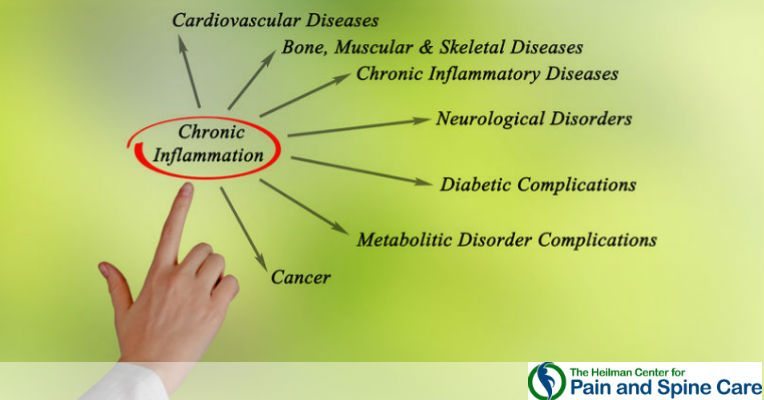If you’ve ever been sick or injured, you’ve experienced inflammation. Inflammation is a normal part of a healthy body’s healing process. But sometimes, inflammation continues even after recovery. This can lead to chronic pain and even life-threatening diseases. How can you manage inflammation? And how do you know when inflammation has become a cause for concern?
What is Inflammation?
Acute inflammation is the body’s protective reaction to infection or injury. Part of the inflammation process is pain, which is caused by swelling tissues pressing on nerves, and the production of chemical substances that send pain signals to the brain. As the injury heals or the body fights off the foreign invader, inflammation diminishes and the body turns off its defensive mode.
Unfortunately, inflammation doesn’t always function perfectly. At times, too many unnecessary inflammatory chemicals are produced, causing chronic inflammation. This is a long-term protective response in which the body acts as if it’s under constant attack. Chronic inflammation is a healthy response gone awry and is at the root of many diseases, including arthritis, heart disease, diabetes, metabolic syndrome, and obesity.
Inflammation can be localized, occurring in only certain parts of the body, or it can affect a certain part or structure. Sciatica, for example, is inflammation of the sciatic nerve. This nerve is the largest in the body, and sciatica pain can be felt anywhere along the nerve’s path, from the lower back to the buttocks and farther down the body. Sciatic nerve inflammation symptoms vary, but can include:
- A stabbing or shooting pain that radiates along your lower back, buttocks, and/or down your legs
- Weakness in the legs
- Worsening of the pain when you stand or sit for too long
- Tingling or numbness in the area along the sciatic pathway
The Causes of Inflammation
There are many different causes of inflammation. If you’re experiencing inflammation, keep in mind that you may have different causes or a different combination of causes.
Some of the most common causes of inflammation are:
- Exposure to certain toxins, such as smog or pesticides
- An injury or infection left untreated for too long
- An autoimmune disorder, such as rheumatoid arthritis or lupus
- Other diseases and conditions, such as asthma, cancer, or heart disease
- Excessive alcohol intake
- Too much or too little exercise
- Abnormal or unrelenting amounts of stress
- Obesity
When it comes to sciatica, some of the most common causes include:
- A torn, slipped, or ruptured disc in the lower back
- Pinching of the sciatic nerve
- An overgrowth of bone
- Anything else that puts extra pressure on the sciatic nerve or area around the sciatic nerve
- The natural wear and tear of aging
- Osteoarthritis
The Effects of Inflammation
Inflammation can have both short-term and long-term effects, and it should be treated right away to help avoid any complications.
Short-term effects of inflammation include symptoms you probably most associate with a common injury:
- Pain
- Redness
- Swelling
- Fever
- Warmness around the injury site
If left untreated, inflammation can become chronic. While the causal link between inflammation and certain other illnesses isn’t always clear, chronic inflammation can definitely contribute to a number of other health conditions:
- Permanent cell damage
- Sleep disorders
- Joint pain
- Mood disorders
- Skin ailments
- Metabolic disorders
- Increased risk of conditions and diseases such as Type 2 Diabetes and cancer
How Can an Anti-Inflammatory Lifestyle Help?
Thankfully, inflammation can be treated and managed. There are over-the-counter anti-inflammatory medicines like aspirin, ibuprofen, and naproxen for quick, short-term relief.
However, real pain relief comes from a few small but important lifestyle changes. By adopting certain anti-inflammatory habits, you can decrease pain, maintain healthy tissues and cells, and live a fuller, happier life.
The Components of an Anti-Inflammatory Lifestyle
An anti-inflammatory lifestyle is more than just eating a certain food or doing a certain type of exercise. Managing chronic inflammation means embracing a holistic approach to the changes in your life. Over time, these small changes can add up to a big difference in how you look and feel.
Consistent Exercise
Regular, moderate exercise helps to reduce acute inflammatory responses, allowing for faster healing. Exercise has also been found to decrease chronic inflammation. The more physically fit a person is, the fewer inflammatory chemicals their body produces. So not only can regular exercise help you heal faster when injured, but you’ll be at less risk for chronic diseases.
If you’re in pain, it’s tempting to skip exercise, but certain, careful movements may help reduce pain and speed up recovery time. That doesn’t mean it’s easy, but keep in mind that there is an exercise for almost everybody out there. If you have an injury, be sure to check with your doctor before starting an exercise program and discuss ways to manage your pain so that you can participate in activities.
Consider walking, swimming, yoga, Tai Chi, Pilates, simple stretching, light weight-lifting and strength training, and aerobic exercises (treadmill, elliptical, stationary bike, etc). Start slow and you’ll be amazed at how much better you can feel.
Anti-Inflammatory Diet & Foods
Foods have been identified and categorized by their ability to increase or decrease chronic inflammation. Some anti-inflammatory foods work similarly to anti-inflammatory medicine.
Rather than including a specific food or two in the diet, it may be beneficial to look at an overall eating plan to lower chronic inflammation.
Start trying to eat more of:
- Vegetables
- Fresh fruits, especially berries
- Small portions of almonds, walnuts, pistachios, flaxseed, and other nuts and seeds
- Whole grain products, brown rice, or bulgur wheat
- Fatty fish (salmon, mackerel, herring, sardines, anchovies, rainbow trout, and Pacific oysters)
- An omega-3 supplement if you don’t like fish
- Green tea and water
- Healthy oils (extra virgin olive oil, and flaxseed oil)
- Ginger, curry, cinnamon, turmeric, saffron, and garlic
- Lentils and beans
- Food that’s been processed as little as possible
Start trying to eat less of:
- High-fat dairy products
- Saturated fats and trans fats
- Refined carbohydrates, such as white sugar and flour
- High-fat meats
- Fried foods
- Foods cooked at high temperatures (charbroiled, grilled, or pan-fried)
- Processed foods
Stress Management
Our reaction to stressful situations can include the production of inflammatory chemicals. Studies support this additional source of chronic inflammation.
Consider meditation, relaxation techniques, cognitive therapy, exercise, and other stress management techniques as part of your overall plan to reduce inflammation.
Maintaining a Healthy Weight
Even more important than the foods you choose to eat, maintaining a healthy weight may be your best defense against chronic inflammation. Fat cells increase inflammation in the body. There are close links between obesity and osteoarthritis, diabetes, heart disease, and metabolic syndrome. The heavier the person, the higher the inflammatory markers and the greater their risk of contracting these diseases.
Reaching and maintaining a healthy weight is easier said than done for most. Keep in mind that even a small amount of weight loss is beneficial, and having a goal of no weight gain is appropriate for many.
The behaviors that could help people to lose weight and maintain that loss include:
- Eating a diet that is lower in fat and calories
- Keeping a log of what you eat (total calories)
- Walking a lot (about an hour a day—it doesn’t have to be all at once)
- Watching less than 10 hours of TV a week
- For those with a BMI of 35 or higher, bariatric surgery may be an option
Getting Enough Sleep
People who don’t sleep long enough (or who have poor quality sleep) tend to have higher levels of inflammation. The magic number hovers around 7-9 hours of sleep per night. Those getting less or more than that usually have higher levels of inflammation. And it’s not just the quantity, but the quality of sleep that counts.
The American Academy of Sleep Medicine has the following tips for getting a good night’s sleep:
- Follow a consistent bedtime routine, even on weekends and vacations
- Establish a relaxing setting at bedtime: as little light as possible in a cool, quiet environment
- Try for 7-9 hours of sleep every night
- Avoid caffeine or any other stimulants at least 6 hours before bedtime
- Find a way to calm your mind
- Don’t go to bed hungry, or too full
- Avoid vigorous exercise within 6 hours of your bedtime
- Make your bedroom quiet, dark, and cool
- Get up at the same time every morning
- Reserve your bed for sleep; avoid working or looking at screens in bed
The Heilman Center Can Help
No one should have to live with chronic pain. The doctors, nurses, and technicians at the Heilman Center will work with you to create a personalized treatment plan so that pain will no longer define your life.
Get in touch with us or call us at 734-345-1361 to find out how our expert staff of pain specialists can help you with your pain management.






